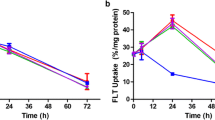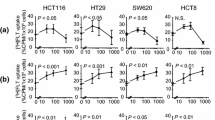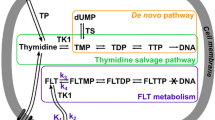Abstract
Purpose
This study aims to demonstrate that 3′-deoxy-3′-18F-fluorothymidine (18F-FLT) positron emission tomography (PET) is a promising modality for noninvasively monitoring the therapeutic efficacy of Doxisome® in a subcutaneous hepatoma mouse model.
Procedures
Male BALB/c nu/nu mice were inoculated with HepG2 hepatoma xenograft in the right flank. Doxisome® (5 mg/kg, three times a week for 2 weeks) was intravenously administrated for treatment. 18F-FLT-microPET, biodistribution studies, and immunohistochemistry of Ki-67 were performed.
Results
A significant difference (p < 0.05) in tumor volume was observed on day 5 between treated and control groups. The tumor-to-muscle ratio derived from 18F-FLT-PET and 123I-ICdR-microSPECT images of Doxisome®-treated mice dropped from 12.55 ± 0.76 to 3.81 ± 0.31 and from 2.48 ± 0.42 to 1.59 ± 0.08 after a three-dose treatment, respectively, while that of the control group remained steady. The retarded proliferation rate of treated xenograft was confirmed by Ki-67 immunohistochemistry staining.
Conclusions
This study clearly demonstrated that Doxisome® is an effective anti-cancer drug against the growth of HepG2 hepatoma and that 18F-FLT-PET could provide early information of tumor response during treatment.







Similar content being viewed by others
References
Been LB, Suurmeijer AJ, Cobben DC et al (2004) [18F]FLT-PET in oncology: current status and opportunities. Eur J Nucl Med Mol Imaging 31:1659–1672
Buck AK, Halter G, Schirrmeister H et al (2003) Imaging proliferation in lung tumors with PET: 18F-FLT versus 18F-FDG. J Nucl Med 44:1426–1431
Kenny LM, Vigushin DM, Al-Nahhas A et al (2005) Quantification of cellular proliferation in tumor and normal tissues of patients with breast cancer by [18F]fluorothymidine-positron emission tomography imaging: evaluation of analytical methods. Cancer Res 65:10104–10112
Moroz MA, Kochetkov T, Cai S et al (2011) Imaging colon cancer response following treatment with AZD1152: a preclinical analysis of [18F]fluoro-2-deoxyglucose and 3′-deoxy-3′-[18F]fluorothymidine imaging. Clin Cancer Res 17:1099–1110
Neshasteh-Riz A, Mairs RJ, Angerson WJ et al (1998) Differential cytotoxicity of [123I]IUdR, [125I]IUdR and [131I]IUdR to human glioma cells in monolayer or spheroid culture: effect of proliferative heterogeneity and radiation cross-fire. Br J Cancer 77:385–390
Blasberg RG, Roelcke U, Weinreich R et al (2000) Imaging brain tumor proliferative activity with [124I]iododeoxyuridine. Cancer Res 60:624–635
Kriss JP, Maruyama Y, Tung LA, Bond SB, Revesz L (1963) The fate of 5-bromodeoxyuridine, 5-bromodeoxycytidine, and 5-iododeoxycytidine in man. Cancer Res 23:260–268
Tewey KM, Rowe TC, Yang L, Halligan BD, Liu LF (1984) Adriamycin-induced DNA damage mediated by mammalian DNA topoisomerase II. Science 226:466–468
Alberts DS, Muggia FM, Carmichael J et al (2004) Efficacy and safety of liposomal anthracyclines in phase I/II clinical trials. Semin Oncol 31:53–90
Kim DW, Ahn DS, Oh YH et al (2006) A new class of SN2 reactions catalyzed by protic solvents: facile fluorination for isotopic labeling of diagnostic molecules. J Am Chem Soc 128:16394–16397
Lin YY, Li JJ, Chang CH et al (2009) Evaluation of pharmacokinetics of 111In-labeled VNB-PEGylated liposomes after intraperitoneal and intravenous administration in a tumor/ascites mouse model. Cancer Biother Radiopharm 24:453–460
Nickoloff BJ, Chaturvedi V, Bacon P et al (2000) Id-1 delays senescence but does not immortalize keratinocytes. J Biol Chem 275:27501–27504
Tournier I, Bernuau D, Poliard A, Schoevaert D, Feldmann G (1987) Detection of albumin mRNAs in rat liver by in situ hybridization: usefulness of paraffin embedding and comparison of various fixation procedures. J Histochem Cytochem 35:453–459
Ho CL, Yu SC, Yeung DW (2003) 11C-acetate PET imaging in hepatocellular carcinoma and other liver masses. J Nucl Med 44:213–221
Porenta G, Cherry S, Czernin J et al (1999) Noninvasive determination of myocardial blood flow, oxygen consumption and efficiency in normal humans by carbon-11 acetate positron emission tomography imaging. Eur J Nucl Med 26:1465–1474
Rubin PJ, Lee DS, Davila-Roman VG et al (1996) Superiority of C-11 acetate compared with F-18 fluorodeoxyglucose in predicting myocardial functional recovery by positron emission tomography in patients with acute myocardial infarction. Am J Cardiol 78:1230–1235
van den Hoff J, Burchert W, Wolpers HG, Meyer GJ, Hundeshagen H (1996) A kinetic model for cardiac PET with [1-carbon-11]-acetate. J Nucl Med 37:521–529
Park JW, Kim JH, Kim SK et al (2008) A prospective evaluation of 18F-FDG and 11C-acetate PET/CT for detection of primary and metastatic hepatocellular carcinoma. J Nucl Med 49:1912–1921
Dittmann H, Jusufoska A, Dohmen BM et al (2009) 3′-Deoxy-3′-[18F]fluorothymidine (FLT) uptake in breast cancer cells as a measure of proliferation after doxorubicin and docetaxel treatment. Nucl Med Biol 36:163–169
Chen YL, Eriksson S, Chang ZF (2010) Regulation and functional contribution of thymidine kinase 1 in repair of DNA damage. J Biol Chem 285:27327–27335
Kratz F, Muller IA, Ryppa C, Warnecke A (2008) Prodrug strategies in anticancer chemotherapy. ChemMedChem 3:20–53
Leonard RC, Williams S, Tulpule A, Levine AM, Oliveros S (2009) Improving the therapeutic index of anthracycline chemotherapy: focus on liposomal doxorubicin (Myocet). Breast 18:218–224
Lombardi G, Zustovich F, Farinati F et al (2011) Pegylated liposomal doxorubicin and gemcitabine in patients with advanced hepatocellular carcinoma: results of a phase 2 study. Cancer 117:125–133
Lin YY, Chang CH, Li JJ et al (2011) Pharmacokinetics and dosimetry of 111In/188Re-labeled PEGylated liposomal drugs in two colon carcinoma-bearing mouse models. Cancer Biother Radiopharm 26:373–380
Lee WC, Chang CH, Ho CL et al (2011) Early detection of tumor response by FLT/microPET Imaging in a C26 murine colon carcinoma solid tumor animal model. J Biomed Biotechnol 2011:535902
Dresdale A, Bonow RO, Wesley R et al (1983) Prospective evaluation of doxorubicin-induced cardiomyopathy resulting from postsurgical adjuvant treatment of patients with soft tissue sarcomas. Cancer 52:51–60
Shields AF (2012) PET imaging of tumor growth: not as easy as it looks. Clin Cancer Res 18:1189–1191
Zhang CC, Yan Z, Li W et al (2012) [18F]FLT-PET imaging does not always “light up” proliferating tumor cells. Clin Cancer Res 18:1303–1312
Acknowledgments
The authors thank the financial support from the National Science Council, Taiwan (NSC100-2623-E-010-003-NU and NSC99-NU-E-010-003), Department of Health, Taipei City Government, Taiwan (99001-62-034), and Cheng Hsin General Hospital, Taiwan (98F117CY07). The authors also appreciate the technical support from the National Research Program for Genetic Medicine, Taiwan (Molecular and Genetic Core, NSC100-2319-B-010-003).
Conflict of Interest
The authors declare that they have no conflict of interest.
Author information
Authors and Affiliations
Corresponding authors
Rights and permissions
About this article
Cite this article
Wu, CY., Chou, LS., Chan, PC. et al. Monitoring Tumor Response with Radiolabeled Nucleoside Analogs in a Hepatoma-Bearing Mouse Model Early After Doxisome® Treatment. Mol Imaging Biol 15, 326–335 (2013). https://doi.org/10.1007/s11307-012-0604-9
Published:
Issue Date:
DOI: https://doi.org/10.1007/s11307-012-0604-9




